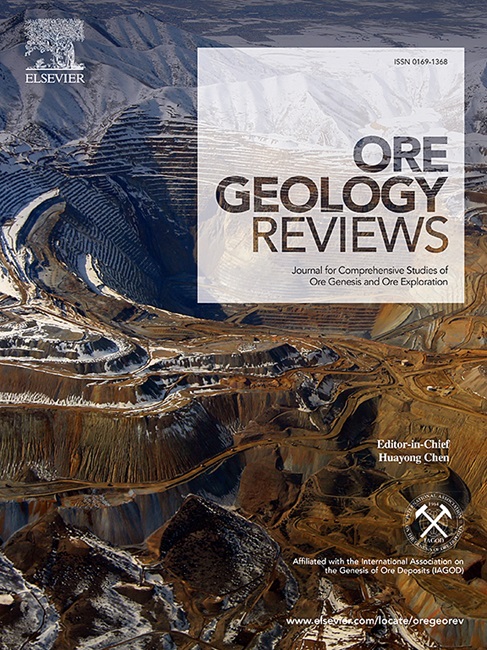Fluorescent sphalerite rich in tungsten, copper, gallium, silver, and other elements from the Cordilleran-style, polymetallic veins of Philipsburg, Montana
IF 3.2
2区 地球科学
Q1 GEOLOGY
引用次数: 0
Abstract
Sphalerite from the central, high-sulfidation zone (enargite-stable) of the Philipsburg polymetallic mining district, southwest Montana, displays unusually bright fluorescence (red, orange, yellow, blue, purple, green) under longwave UV light (365 nm). LA-ICP-MS analysis reveals the fluorescent sphalerite has very low Fe (average < 100 ppm) and variable content of other trace elements that correlate to luminescence color banding. Mean/maximum content (in ppm) in fluorescent sphalerite for selected elements are 5.7/7900 Ag, 107/11800 As, 1400/4730 Cd, 917/30400 Cu, 381/5000 Ga, 32/696 Ge, 119/2130 In, 230/8190 Mn, 43/3000 Pb, 16/1700 Sb, and 89/1980 W. This study is the first to document elevated tungsten content (>10 ppm) in sphalerite. Copper is closely correlated with Ga, consistent with the coupled substitution: Cu+ + Ga3+ = 2Zn2+. Similar coupled substitution reactions can be written for Ag+, In3+, As3+, Sb3+, Bi3+, and Ge4+. However, the brightest red fluorescent bands are most closely related to the unexpected presence of W. Sphalerite with high Cu and Ga but lacking W fluoresces yellow and shows a single Raman peak at 349 cm−1 corresponding to pure sphalerite. In contrast, red-fluorescent sphalerite shows the presence of a second peak at 427 cm−1 that increases in intensity with increased W content. We propose that tungsten enters the sphalerite lattice as W6+ via a substitution such as W6+ + 4Cu+ = 5Zn2+ and that this substitution creates lattice strain that results in the anomalous fluorescence and Raman signals. Sphalerite bands with low concentrations of Cu and Ga fluoresce blue or green. Vivid blue fluorescence is displayed by sphalerite with high Cd (>1000 ppm) but low concentrations of all other trace elements. Sphalerite from the low-sulfidation peripheral mines of the Philipsburg district contains high Fe (>10,000 ppm) and does not fluoresce. Nonetheless, this sphalerite is also highly enriched in trace metals, including Ag (mean 2480/max 8660 ppm), Cu (1610/3440), Mn (7020/8100), and Sb (1960/6390). The results of this study underscore the importance of including tungsten in the list of analytes in future studies of trace elements in sphalerite. In addition, a hand-held UV lamp may be a rapid and cost-effective method to screen sphalerite of variable composition in outcrop or drill core. It may be a useful exploration tool to vector towards a high-sulfidation zone of a zoned porphyry or epithermal deposit, when it is present.

蒙大拿州菲利普斯堡科迪勒拉山风格多金属矿脉中富含钨、铜、镓、银和其他元素的荧光闪锌矿
蒙大拿州西南部菲利普斯堡多金属矿区中部高硫化区(enargite-stable)的闪锌矿在长波紫外光(365 纳米)下显示出异常明亮的荧光(红、橙、黄、蓝、紫、绿)。LA-ICP-MS 分析显示,荧光闪锌矿的铁含量非常低(平均为 100 ppm),其他微量元素的含量也不尽相同,这与荧光色带相关。荧光闪锌矿中某些元素的平均/最大含量(ppm)分别为:5.7/7900 Ag、107/11800 As、1400/4730 Cd、917/30400 Cu、381/5000 Ga、32/696 Ge、119/2130 In、230/8190 Mn、43/3000 Pb、16/1700 Sb 和 89/1980 W。铜与镓密切相关,与耦合置换相一致:Cu+ + Ga3+ = 2Zn2+。Ag+、In3+、As3+、Sb3+、Bi3+ 和 Ge4+ 也可以发生类似的耦合置换反应。然而,最明亮的红色荧光带与 W 的意外存在关系最为密切。含有大量铜和镓但缺乏 W 的闪锌矿发出黄色荧光,并在 349 cm-1 处显示出与纯闪锌矿相对应的单拉曼峰。与此相反,红色荧光闪锌矿在 427 cm-1 处显示出第二个峰值,该峰值的强度随着钨含量的增加而增加。我们认为,钨是通过 W6+ + 4Cu+ = 5Zn2+ 等置换作用以 W6+ 的形式进入闪锌矿晶格的,这种置换作用产生了晶格应变,从而导致异常荧光和拉曼信号。含低浓度铜和镓的闪锌矿带发出蓝色或绿色荧光。镉含量高(1000 ppm)但所有其他微量元素含量低的闪锌矿会发出鲜艳的蓝色荧光。来自菲利普斯堡地区低硫化周边矿山的闪锌矿含有较高的铁(>10,000 ppm),不会发出荧光。尽管如此,这种闪锌矿的微量金属含量也很高,包括银(平均 2480/最高 8660 ppm)、铜(1610/3440)、锰(7020/8100)和锑(1960/6390)。这项研究的结果强调了在今后的闪锌矿痕量元素研究中将钨纳入分析物清单的重要性。此外,手持式紫外灯可能是筛选露头或钻芯中不同成分闪锌矿的一种快速、经济有效的方法。如果存在带状斑岩或热液矿床的高硫化区,它可能是一种有用的勘探工具。
本文章由计算机程序翻译,如有差异,请以英文原文为准。
求助全文
约1分钟内获得全文
求助全文
来源期刊

Ore Geology Reviews
地学-地质学
CiteScore
6.50
自引率
27.30%
发文量
546
审稿时长
22.9 weeks
期刊介绍:
Ore Geology Reviews aims to familiarize all earth scientists with recent advances in a number of interconnected disciplines related to the study of, and search for, ore deposits. The reviews range from brief to longer contributions, but the journal preferentially publishes manuscripts that fill the niche between the commonly shorter journal articles and the comprehensive book coverages, and thus has a special appeal to many authors and readers.
 求助内容:
求助内容: 应助结果提醒方式:
应助结果提醒方式:


